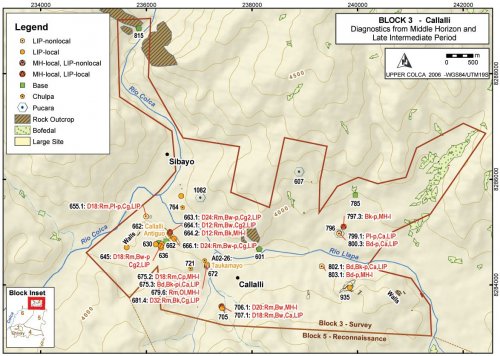Middle Horizon and Late Intermediate Period
As has been discussed above, the role of regional states in the Colca valley during the Middle Horizon is somewhat enigmatic. Wari influences are apparent in architecture and ceramic attributes, but direct evidence of Wari control has not been encountered. No evidence of Tiwanaku, a principal consumer of Chivay obsidian, has been encountered in the region. The local Middle Horizon ceramic type defined by Wernke (2003) was encountered in low densities in Block 3, although generally in spatial association with LIP sherds suggesting a continuity of economic and settlement patterns.
During the Late Intermediate Period there appears to have been a significant increase in population in the Block 3 region. The founding myth of the Collagua people, as recorded by a Spanish ethnohistoric source, has them conquering the Colca valley upon their descent from the Mount Collaguata near Velille in Espinar (Cusco) 120 km north of this region (Ulloa Mogollón 1965 [1586]; cited in Wernke 2003: 80). Data is not available from this surface survey to test the alleged population replacement, but some continuity in land use pattern is apparent from the occupation of areas with both local Middle Horizon ceramics and LIP ceramics.
One site that shows ceramics from throughout the sequence that includes the possible Formative Period (Chiquero), the Middle Horizon, LIP, and Late Horizon, is the site of Taukamayo [A02-26] discussed in more detail in Early Agropastoral section (seeFigure 6-60). This site has been partially destroyed by a creeping landslide that has resulted in shuffling of stratigraphy within the displaced slump deposit and the exposure of a variety of artifacts from the prehistoric sequence. In the creep debris there are concentrations of stone associated with LIP and LH ceramics that suggest that chulpas, perhaps similar to the one observed at a site immediately to the north [A03-673], were built along the terrace that has since collapsed in the creep.
 Figure6-78. Block 3 Middle Horizon and Late Intermediate Period features.
Figure6-78. Block 3 Middle Horizon and Late Intermediate Period features.
Distinctive features from the LIP include a number of shared features from the Titicaca Basin mentioned previously. These consist of pukaras, chulpasand distinctive types of cave burials. Pukaras are fortified hilltops settlements usually occupied only for short-term, defensive purposes (Arkush 2005;Stanish 2003: 209-218;Wernke 2003: 251-265).
